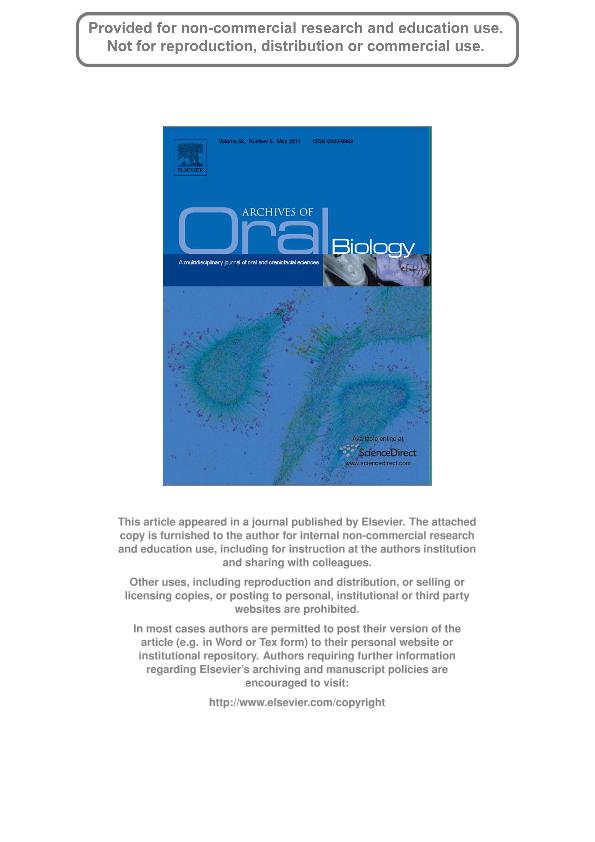Artículo
Reduced methacholine-induced submandibular salivary secretion in rats with experimental periodontitis
Amer, Mariano; Elverdin, Juan Carlos; Fernández Solari, Jose Javier ; Medina, Vanina Araceli
; Medina, Vanina Araceli ; Chiarenza, Ana P.; Vacas, María I.
; Chiarenza, Ana P.; Vacas, María I.
 ; Medina, Vanina Araceli
; Medina, Vanina Araceli ; Chiarenza, Ana P.; Vacas, María I.
; Chiarenza, Ana P.; Vacas, María I.
Fecha de publicación:
05/2011
Editorial:
Elsevier
Revista:
Archives of Oral Biology
ISSN:
0003-9969
Idioma:
Inglés
Tipo de recurso:
Artículo publicado
Clasificación temática:
Resumen
OBJECTIVE: Saliva is the first barrier to the entry of bacteria and viruses into the body and is considered a necessary instrument in oral health. Intraperitoneal injection of lipopolysaccharide endotoxins results in submandibular gland (SMG) hyposalivation. The objective of present studies was to assess if periodontitis, a chronic inflammatory disease caused by oral bacteria, alters cholinergic-induced SMG salivary secretion. DESIGN: An experimental periodontitis model (EP) (cotton thread ligature around the neck of the first lower molars) was used. Male Wistar rats (300-380g) were randomly divided into 3 groups: control, 7 days-bilateral EP and 7 days-unilateral EP (to study if there were different effects at the ipsilateral and contralateral side). The following determinations were performed in SMG: (1) dose-response curves to the cholinergic agonist methacholine, (2) prostaglandin E (PGE) content, (3) inducible nitric oxide synthase (iNOS) activity and (4) histology of gland sections. RESULTS: The molars with EP, no matter the group, exhibited significant and similar bone loss (p<0.001). Bilateral EP reduced methacholine-induced salivary secretion (p<0.05, dose 1μg/kg; p<0.001, dose 3-30μg/kg), increased PGE content (p<0.01), stimulated iNOS activity (p<0.05). Ipsilateral glands of unilateral EP animals presented lower methacholine-induced salivary secretion (p<0.05, dose 3μg/kg; p<0.001, dose 10-30μg/kg), and higher PGE content than contralaterals (p<0.001). In turn, at 3 and 10μg/kg of methacholine, contralateral glands showed significantly lower secretion than control animals (p<0.001). Histological studies of glands revealed partial loss of secretor granular material and periductal oedema in the bilateral and unilateral EP groups as compared to controls. CONCLUSIONS: As far as we know, the present results demonstrate for the first time that EP reduces methacholine-induced SMG salivary secretion.
Palabras clave:
Periodontal Diseases
,
Submandibular Gland
,
Salivary Secretion
,
Inos
,
Pge
Archivos asociados
Licencia
Identificadores
Colecciones
Articulos(CEFYBO)
Articulos de CENTRO DE ESTUDIOS FARMACOLOGICOS Y BOTANICOS
Articulos de CENTRO DE ESTUDIOS FARMACOLOGICOS Y BOTANICOS
Articulos(OCA HOUSSAY)
Articulos de OFICINA DE COORDINACION ADMINISTRATIVA HOUSSAY
Articulos de OFICINA DE COORDINACION ADMINISTRATIVA HOUSSAY
Citación
Amer, Mariano; Elverdin, Juan Carlos; Fernández Solari, Jose Javier; Medina, Vanina Araceli; Chiarenza, Ana P.; et al.; Reduced methacholine-induced submandibular salivary secretion in rats with experimental periodontitis; Elsevier; Archives of Oral Biology; 56; 5; 5-2011; 421-427
Compartir
Altmétricas



